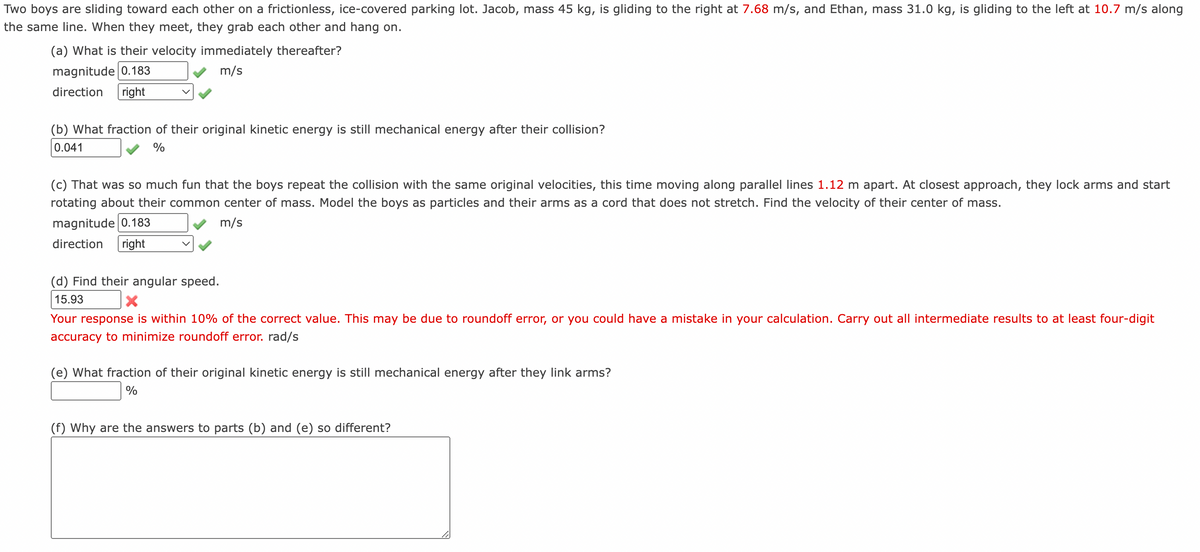Two boys are sliding toward each other on a frictionless, ice-covered parking lot. Jacob, mass 45 kg, is gliding to the right at 7.68 m/s, and Ethan, mass 31.0 kg, is gliding to the left at 10.7 m/s along the same line. When they meet, they grab each other and hang on. (a) What is their velocity immediately thereafter? magnitude 0.183 direction right m/s (b) What fraction of their original kinetic energy is still mechanical energy after their collision? 0.041 (c) That was so much fun that the boys repeat the collision with the same original velocities, this time moving along parallel lines 1.12 m apart. At closest approach, they lock arms and start rotating about their common center of mass. Model the boys as particles and their arms as a cord that does not stretch. Find the velocity of their center of mass. magnitude 0.183 right m/s direction (d) Find their angular speed. 15.93 Your response is within 10% of the correct value. This may be due to roundoff error, or you could have a mistake in your calculation. Carry out all intermediate results to at least four-digit
Two boys are sliding toward each other on a frictionless, ice-covered parking lot. Jacob, mass 45 kg, is gliding to the right at 7.68 m/s, and Ethan, mass 31.0 kg, is gliding to the left at 10.7 m/s along the same line. When they meet, they grab each other and hang on. (a) What is their velocity immediately thereafter? magnitude 0.183 direction right m/s (b) What fraction of their original kinetic energy is still mechanical energy after their collision? 0.041 (c) That was so much fun that the boys repeat the collision with the same original velocities, this time moving along parallel lines 1.12 m apart. At closest approach, they lock arms and start rotating about their common center of mass. Model the boys as particles and their arms as a cord that does not stretch. Find the velocity of their center of mass. magnitude 0.183 right m/s direction (d) Find their angular speed. 15.93 Your response is within 10% of the correct value. This may be due to roundoff error, or you could have a mistake in your calculation. Carry out all intermediate results to at least four-digit
College Physics
11th Edition
ISBN:9781305952300
Author:Raymond A. Serway, Chris Vuille
Publisher:Raymond A. Serway, Chris Vuille
Chapter6: Momentum, Impulse, And Collisions
Section: Chapter Questions
Problem 46P: A space probe, initially at rest, undergoes an internal mechanical malfunction and breaks into three...
Related questions
Topic Video
Question

Transcribed Image Text:Two boys are sliding toward each other on a frictionless, ice-covered parking lot. Jacob, mass 45 kg, is gliding to the right at 7.68 m/s, and Ethan, mass 31.0 kg, is gliding to the left at 10.7 m/s along
the same line. When they meet, they grab each other and hang on.
(a) What is their velocity immediately thereafter?
magnitude 0.183
m/s
direction
right
(b) What fraction of their original kinetic energy is still mechanical energy after their collision?
0.041
(c) That was so much fun that the boys repeat the collision with the same original velocities, this time moving along parallel lines 1.12 m apart. At closest approach, they lock arms and start
rotating about their common center of mass. Model the boys as particles and their arms as a cord that does not stretch. Find the velocity of their center of mass.
magnitude 0.183
right
m/s
direction
(d) Find their angular speed.
15.93
Your response is within 10% of the correct value. This may be due to roundoff error, or you could have a mistake in your calculation. Carry out all intermediate results to at least four-digit
accuracy to minimize roundoff error. rad/s
(e) What fraction of their original kinetic energy is still mechanical energy after they link arms?
%
(f) Why are the answers to parts (b) and (e) so different?
Expert Solution
This question has been solved!
Explore an expertly crafted, step-by-step solution for a thorough understanding of key concepts.
This is a popular solution!
Trending now
This is a popular solution!
Step by step
Solved in 2 steps with 4 images

Knowledge Booster
Learn more about
Need a deep-dive on the concept behind this application? Look no further. Learn more about this topic, physics and related others by exploring similar questions and additional content below.Recommended textbooks for you

College Physics
Physics
ISBN:
9781305952300
Author:
Raymond A. Serway, Chris Vuille
Publisher:
Cengage Learning

College Physics
Physics
ISBN:
9781285737027
Author:
Raymond A. Serway, Chris Vuille
Publisher:
Cengage Learning

Physics for Scientists and Engineers: Foundations…
Physics
ISBN:
9781133939146
Author:
Katz, Debora M.
Publisher:
Cengage Learning

College Physics
Physics
ISBN:
9781305952300
Author:
Raymond A. Serway, Chris Vuille
Publisher:
Cengage Learning

College Physics
Physics
ISBN:
9781285737027
Author:
Raymond A. Serway, Chris Vuille
Publisher:
Cengage Learning

Physics for Scientists and Engineers: Foundations…
Physics
ISBN:
9781133939146
Author:
Katz, Debora M.
Publisher:
Cengage Learning

Principles of Physics: A Calculus-Based Text
Physics
ISBN:
9781133104261
Author:
Raymond A. Serway, John W. Jewett
Publisher:
Cengage Learning

University Physics Volume 1
Physics
ISBN:
9781938168277
Author:
William Moebs, Samuel J. Ling, Jeff Sanny
Publisher:
OpenStax - Rice University

Glencoe Physics: Principles and Problems, Student…
Physics
ISBN:
9780078807213
Author:
Paul W. Zitzewitz
Publisher:
Glencoe/McGraw-Hill